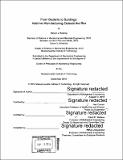From bacteria to buildings : additive manufacturing outside the box
Author(s)
Keating, Steven J. (Steven John)
DownloadFull printable version (41.42Mb)
Other Contributors
Massachusetts Institute of Technology. Department of Mechanical Engineering.
Advisor
Neri Oxman and David R. Wallace.
Terms of use
Metadata
Show full item recordAbstract
Additive manufacturing has been hailed as the next fabrication revolution with visions of customization, decentralization, and rapid production. Yet with over three decades of progress, limitations associated with poor material properties, slow fabrication speeds, expensive cost, and volumetric size constraints continue to disappoint. How can we move beyond the current dimensional limits of additive manufacturing and escape the printer's 'box'? What are the routes to 3D print a house, a microfluidic system, or a biological scaffold? Can we produce an Additive Manufacturing Map? This thesis focuses on expanding the limits of additive manufacturing through novel experimental developments across material, spatial, and temporal dimensions. A dimensional additive manufacturing mapping methodology for plotting theoretical and experimental results is generated and discussed. Research into the material dimension resulted in new additive fabrication techniques for construction. Processes include printed insulated formwork, robotically welded metal chain, and techniques using locally sourced materials (sand, natural fibers, soil, and ice). Research into the spatial dimension includes the design, fabrication, and characterization of a mobile Digital Construction Platform capable of 3D printing architectural-scale structures. The platform has a diametrical reach of over 20 m through a compound arm system and can autonomously drive, gather local materials, self-charge via photovoltaics, and fabricate structures larger than itself. A 14.6 m by 3.7 m proof-of-concept structure was successfully 3D printed onsite with a machine manufacturing time under 13.5 hours. Research into microscopic scale fabrication produced a fractal glass electro-sintering technique and initial investigations into a combination one- and two-photon polymerization 3D printer. Research into the temporal dimension focused on fabrication techniques using biomaterials and living systems, such as thermal deposition of squid sucker ring teeth protein, and 3D printable microfluidics. Developments include printable structures to host cellular life, and the design and characterization of a multi-material microfluidic proportional valve. The projects were evaluated with a dimensional methodology workflow, generating an additive manufacturing map. With this mapping methodology, quantified queries, evaluations, and designs - for various additive fabrication tasks dependent on a value proposition - can be responded to, analyzed, and built.
Description
Thesis: Ph. D., Massachusetts Institute of Technology, Department of Mechanical Engineering, 2016. Vita. Cataloged from PDF version of thesis. Includes bibliographical references (pages 238-242).
Date issued
2016Department
Massachusetts Institute of Technology. Department of Mechanical EngineeringPublisher
Massachusetts Institute of Technology
Keywords
Mechanical Engineering.